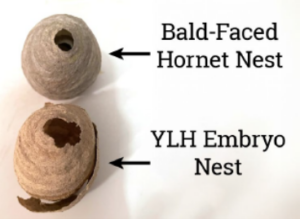
May 13, 2024North Carolina Department of Agriculture issues alert for invasive yellow-legged hornet
The North Carolina Department of Agriculture and Consumer Services Plant Industry Division has sent out a notice asking state residents and growers to be on the lookout for the early-stage nests of the Yellow-legged hornet, a non-native pest that is a threat to honeybees.
While this invasive hornet species has not been found in North Carolina, it has been collected in Georgia and the southernmost point of South Carolina in 2023 and 2024.
“The yellow-legged hornet (Vespa velutina) is no more harmful to humans than other hornets, but it can have a devastating impact on both managed and wild bees, especially honeybees,” said Steve Troxler, agriculture commissioner for North Carolina Department of Agriculture. “That is why it’s a species to watch and be concerned about.”

The yellow-legged hornet is native to Southeast Asia and has established itself in most of Europe and areas of the Middle East. The yellow-legged hornet was first detected in the United States in Savannah, Ga. in August 2023, and was identified across the South Carolina line in Jasper County the following November. The hornet builds egg-shaped paper nests above ground and often in trees. Mature nests can be large and house an average of 6,000 workers.
This exotic hornet may be confused with several native insects, including the cicada killer wasp, the bald-faced hornet, paper wasps, queen yellowjackets, wood wasps and robber flies, but is distinguished from these other stinging insects by its larger size.
This Spring, yellow-legged hornet embryo nests, also known as Stage 1 nests, have been found in both Georgia and South Carolina.
Embryo nests are the brownish color of a paper bag and are relatively small, ranging between the size of a ping-pong ball and tennis ball. These smaller, early season nests are constructed by hornet queens to initiate new colonies and are usually found in protected places such as the eaves of homes and other structures.
“As residents are outside in their yards or other areas this Spring, it’s a good time to look for this pest’s early-stage nests on the sides of houses, barns, sheds, pumphouses and other structures with eaves. The nests are brownish in color compared to the gray paper hornets nests many people are familiar with,” Troxler said.

Anyone who finds a suspected nest or hornet should report their findings along with photos to their regional apiary inspector (found here) or submit via a fillable reporting form. Suspect nests should be left undisturbed to allow for proper disposal by inspectors.
To learn more about the hornet, visit this Clemson University publication.
Acknowledgement to Clemson University – Department of Plant Industry and Georgia Department of Agriculture for supporting information and images was provided in the press release from the Department of Agriculture and Consumer Services Plant Industry Division.









